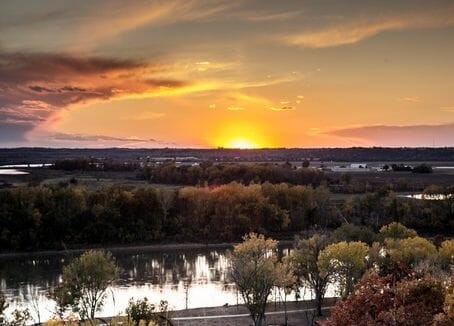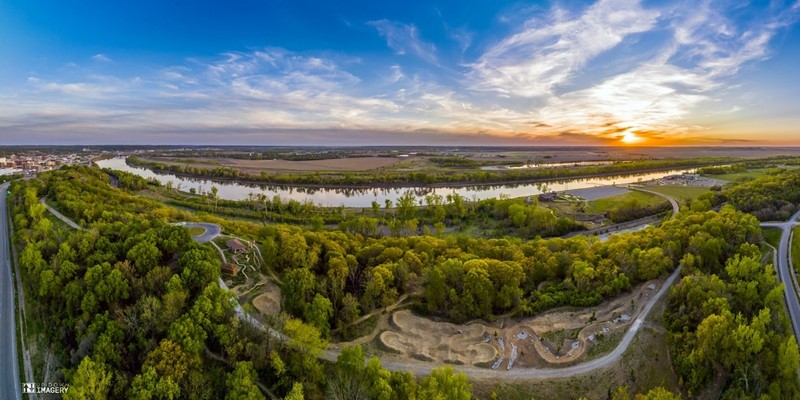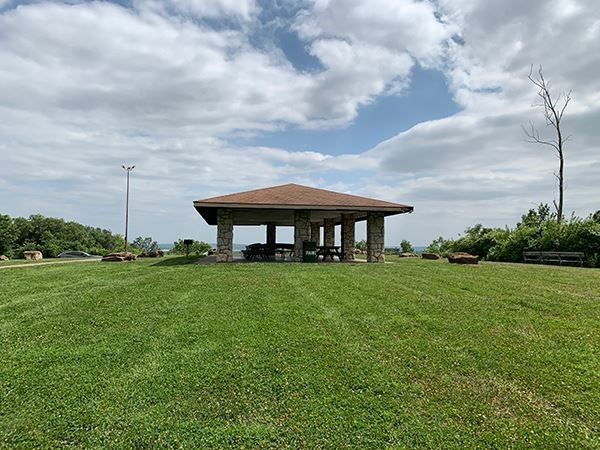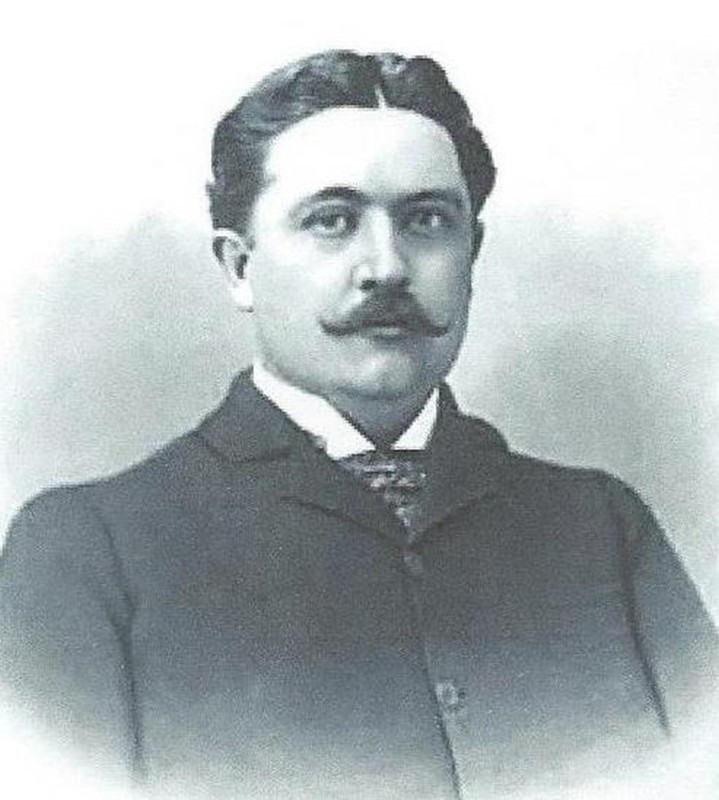Huston Wyeth Park
Introduction
Text-to-speech Audio
Huston Wyeth Park is one of the most scenic places in St. Joseph. Situated atop the bluffs overlooking the Missouri River this wonderful park has inviting walking trails and picnic facilities. It is a favorite place to watch the annual air show at Rosecrans Airport and the 4th of July fireworks.
Images
Huston Wyeth Park offers unparalleled views across the Missouri River

The mighty Missouri River stretches out below the park

It's a great place to have a picnic!

Huston Wyeth

Backstory and Context
Text-to-speech Audio
In 1925, the heirs of Huston Wyeth gave the city of St. Joseph a 26-acre tract of land on Prospect Hill for use as a park to be named in his honor. Huston Wyeth was born on July 8, 1863, in St. Joseph to William and Eliza Wyeth. William had made a fortune in the hardware business and Huston followed in his father’s footsteps. He took an early interest in business, investing in cattle at age 17. This interest led him to attend the Racine Business College in Racine, Wisconsin. When he came back to St. Joseph, he went to work in the family business, Wyeth Hardware. He was made Vice-President in 1888 and he took over the reigns of the business upon his father’s death in 1901. Huston founded St. Joseph Artesian Ice and Cold Storage Company, Blue Valley Creamery Company, and Standard Vitrified Brick Company of Coffeyville, KS. He had dealings in real estate, railroads, and utilities. He married Leila Ballinger in 1883 and the couple had four children. Wyeth became a renowned breeder of German Shepherds, mastiffs, cattle, and trotting horses. He built the substantial Wyethwood Estate on Frederick Ave. (completed in 1922). He died at his winter home in Miami, FL.
The citizens of the north side of St. Joseph were greatly excited by the possibility of this new park. In August 1925 when the City Council met to formally discuss and vote on accepting the gift, more than 150 people attended the meeting to encourage the Council to vote yes. The crowd carried signs and even had a brass band! Not surprisingly, the Council accepted the gift. Quickly, Huston Wyeth Park became one of the most beloved parks in the city, despite the fact that – at that time – the only access to the park was across a rickety wooden bridge. When the bridge failed in September 1928 after a heavy rain, the park was inaccessible for several months before the bridge was repaired.
The scenic nature of the park has made it a popular gathering place for nearly a century. More than 4,000 people joined Mayor Louis V. Stigall at a band concert at the park in July 1928. Its wooded and hilly terrain made it a perfect location for scouting events. Since the 1930s people have gone to Wyeth Park to watch air shows at Rosecrans Airport.
Much of the current appearance of the park and the surrounding bluffs is a result of the Works Progress Administration (WPA). Evocative stone shelter buildings built at this time are still there. This project included creating a new roadway to provide access to the park.
In the 1950s, improvements continued to be made to the park. The Wyeth Company gifted a shelter house to be constructed by the Lehr Construction Company. In 1954, the bridge providing automobile access to the park was in poor condition and the issue of safe access to the park once again came to public attention. The bridge was closed to vehicular traffic for more than six months. The Council agreed to appropriate $10,500 for repair work to the viaduct leading to the park.
In the mid-1970s the City decided to further develop Huston Wyeth Park into “a major element in the park system.” This development included the improvement of the access roadway, the installation of new restrooms, and new lighting.
Between 2022 and 2023, Huston Wyeth Park received multiple upgraded amenities. The park acts as the southern trailhead of River Bluff Trails Park, a primitive trail destination. Connecting Huston Wyeth Park to the bluffs is the Bob Simpson Bridge dedicated in the fall of 2023 in honor of Bob Simpson (1933-2020). Mr. Simpson was a bridge-builder who, over several decades reached out and brought many disparate groups together for the benefit of St. Joseph and its citizens. He had a strong desire to elevate St. Joseph as the true gateway to the West due to the number of trails that crossed through this area, now known as the “King of the Trails.” While having a passion for the underserved, Bob was known as a visionary for what St. Joseph could become. He believed that the strongest partnerships occurred when businesses, government, and philanthropists worked together to make communities a better place to live. Instinctively, he understood that St. Joseph’s best future was connected to its colorful, historic past: those journeying west as part of the great migration, the role the Missouri River played in the lives of the early settlers, such as Joseph Robidoux, the Pony Express, and Jesse James. These extraordinary people and events sparked his imagination to bring residents and tourists alike along the path to bring the region’s rich past to the present. As you walk these historic trails, listen closely, you too may hear the stories of early Americans who traversed this land in search of opportunity and left greatness in their wake.
Located where the playground was previously, a new mountain bike pump track can be found. It is split into two sections: balance bike-friendly tracks and more advanced. Funding has been secured to pave the tracks in the coming years. Multiple primitive trails can also be discovered. These new additions make for a prime location for nature lovers to escape the city.
Huston Wyeth Park remains a favorite destination for anyone who wants amazing views across the Missouri River, some bird watching, or a lovely hike.
Sources
“Huston Wyeth Heirs Give Park to City,” St. Joseph News Press, July 23, 1925.
“While He Chatted with Loved Ones,” St. Joseph Observer, Jan. 30, 1925.
“Council Asked to Extend Wyeth Park,” St. Joseph News Press, Aug. 4, 1925.
“Up on Prospect Hill,” St. Joseph News Press, Aug. 14, 1926.
“Hill Park is Popular,” St. Joseph News Press, June 23, 1927.
“4,000 Hear Band,” St. Joseph Gazette, July 20, 1928.
“Dug Cut Bridge Closed,” St. Joseph News Press, Sept. 13, 1928.
“Club Supper,” St. Joseph News Press, June 17, 1929.
“Farewell Party,” St. Joseph News Press, Oct. 2, 1929.
“City Officials on Picnic at Huston Wyeth Park,” St. Joseph Gazette, Oct. 4, 1930.
“Scout Courts Tonight,” St. Joseph News Press, July 27, 1931.
“Air Show to Return,” St. Joseph News Press, Oct. 12, 1932.
“Edge of Bluffs is Now Taking Form,” St. Joseph News Press, Oct. 12, 1934.
“New Drive to Hill Top,” St. Joseph News Press, Nov. 26, 1935.
“Federal Park Camp Here to Close Jan. 1,” St. Joseph Gazette, Dec. 28, 1937.
“Naval Breakfast Sunday at Huston Wyeth Park,” St. Joseph Gazette, May 30, 1951.
“Wyeth Co. Makes Gift of Park Shelter House to City,” St Joseph News Press, Nov. 4, 1951.
“Needed: A Route to Wyeth Park,” St. Joseph News Press, Oct. 8, 1954.
“Council to Allot Funds for Viaduct,” St. Joseph News Press, July 19, 1955.
“Huston Wyeth Park Road Will Be Built by City in Spring,” St. Joseph News Press, Jan. 31, 1956.
“Wyeth Park to Become One of Top City Facilities,” St. Joseph Gazette, Feb. 17, 1976.
“CID Funds Sought for Huston Wyeth Park Lights,” St. Joseph News Press, June 10, 1976.
Up Down Photography
